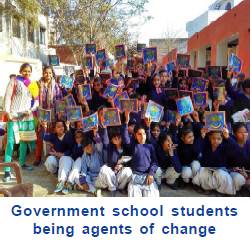Lets WASH and Change the Scenario!
I
ndia has one of the largest number of school going children. There are about 6.3 lakh schools - both primary and upper primary with 8 crore school children. But it is also a fact that only 10-15 percent of schools have sanitation facilities in their premises. Out of 6.3 lakh schools, only 44 percent have separate urinals and 4 percent have separate lavatory facilities for girls. Schools which do have water and sanitation facilities often suffer from:• Nonexistent or insufficient water supply and hand washing facilities.
• Toilets are not adapted to the needs of the children in particular for girls.
• Broken, unsafe water supply, sanitation and hand washing facilities.
• Non-existent and irrelevant hygiene education for children.
• Unhealthy and dirty class rooms and school compounds.
• Improper operation and maintenance of the existing facilities.
Teacher-child-parent-community is a proven route to
spread the message of good and accepted hygiene and sanitary practices and
hence ‘School Sanitation and Hygiene Education’ occupies the pride of place
in a school’s awareness on total sanitation. Good Schools need Good Students
and Good Students need Good Sanitation. Sanitation is at the core of human
dignity and human progress. Access to sanitary facilities not only ensures
dignity of the individual but also positively impacts health, well-being and
productivity, reduces drop-out rates and encourages regular attendance in
schools.
WASH intervention with aspiring students of Gurgaon
(Badshapur Girls high school, Khirkhi Dhaula Primary Boys Schools and Khirkhi Dhaula Primary Girls Schools, Gurgaon)
To foster change in the minds of people, a ‘Student Led Awareness Campaign’ was designed to foster good WASH practices among students supported by availability and accessibility of safe water and sanitation facility. The campaign focused on two main components - Education and Application.
As part of Education component, students were made aware on good water, sanitation and hygiene practices using interactive communication tools so that these messages are imbedded deeply in their day to day lives. In the Application component of the campaign, the children were empowered to apply the knowledge not only in their lives but also in the lives of the people living in their community.
The campaign was designed on the principle 4 A’s approach of Community Led Environment Awareness Network-India (CLEAN-India) programme. The 4A’s stand for Assessment, Awareness, Action and Advocacy. Different components of the campaign were embedded in each of the 4As. The campaign worked towards empowering students and providing them with knowledge about the scientific tools and skills for assessing the water quality and the sanitation situation. The sensitised students stimulate necessary actions for improving the water and sanitation situation of their own school and community with their peers and teachers.

The campaign brought a wave of change in the targeted 3 schools of Gurgaon. In the duration of 6 months, 120 WASH Ambassadors were created in schools which mobilised more than 1700 individuals to adopt good WASH practices. Bringing change in the behavioural practices is a long process and the desired changes are visible only after a certain period of time. Inclusiveness at all the levels is important to bring behaviour change. ■
Vandana Saini
vsaini@devalt.org